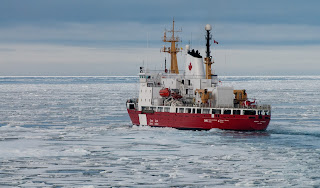Having
just about had time to browse my images from the Northwest Passage and reformat
my memory cards, it's time to pack up and escape the country again. This time
replaying another 19th Century journey.
The
Northwest Passage trip provided the chance to get a glimpse of some of the
places visited by a number of early Arctic explorers, and most particularly to visit some
of bleak and desolate islands that Sir John Franklin and his fellow travellers
saw on their fateful expedition in 1846.
 |
| Graves from Franklin expedition on Beechey Island |
Visiting some of these islands from the comfort of a well-appointed
expedition cruise ship really brought home the challenges that these explorers
faced. They were seeking to find routes
through a maze of islands surrounded at best by drifting sea ice and at worst
by wild Arctic storms. They were trying
to find their way through uncharted waters, where one of their few modern instruments was,
in modern terminology 'useless'.
 |
| Magnetic Compass Useless |
To
supplement paper charts we not only had radar to help spot icebergs and GPS to
confirm where we were, we also had daily ice charts to help us understand what
the ice conditions were. And when the
going got tough we were able to call on the Canadian Coastguard, in the shape
of Captain Frost and the CCGS Henry Larsen, to clear the way for us.
 |
| CCGS Henry Larsen |
There are
further images from the trip on Flickr, and if you want to follow my journey
day-by-day, my photodiary on Blipfoto starts here.
Franklin,
and Roald Amundsen who eventually did sail the Passage in the early years of
the 20th Century, would have been astonished both at the technology at our
disposal, and perhaps even more surprised to find that in the early part of the
21st Century the Northwest Passage is now on the tourist circuit.
Organised
tourism, in Franklin's time, was just starting to develop. Individual travellers had for many years made
journeys or pilgrimages, and the Grand Tour had become a regular rite of passage for
affluent young men. In the middle of the
19th Century, Thomas Cook started for the first time to organise trips
around the UK. In 1863, after a number
of successfully tours to Paris, he decided to branch out and offered his first
international tour to Switzerland. One
of the travellers on the first Swiss tour was Jemina Morrell, a woman from the north of
England who in addition to being an intrepid traveller was also a dedicated
diarist. She wrote, and subsequently
published, a detailed account of her travels through the Bernese Oberland.
Over the
next couple of weeks I'll be repeating Jemima's tour, going to Geneva and
Leukerbad by train and bus, before travelling on by cable car, train, boat and
foot to wind up in Lucerne. I'll be
travelling to several of the towns that Jemima visited as she covered long
distances mostly on foot.
I would
love to be able to say that this tour is still being offered by Thomas Cook,
but it isn't . Our itinerary has been put together by InnTravel.
In the 1860s this trip was state of the art,
modern tourism. In 2013, InnTravel distinguish themselves from other travel companies by the tag-line the 'Slow Holiday People'. I
wonder if there will be mules available for hire if the going gets too slow.
No comments:
Post a Comment